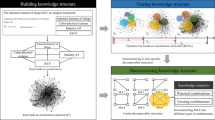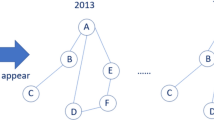Abstract
A knowledge representation model is proposed to facilitate studies on knowledge creation, usage, and evolution. The model uses a three-layer network structure to capture citation relationships among papers, the internal concept structure within individual papers, and the knowledge landscape in a domain. The resulting model can not only reveal the path and direction of knowledge diffusion, but also detail the content of knowledge transferred between papers, new knowledge added, and changing knowledge landscape in a domain. A pilot experiment is carried out using the PMC-OA dataset in the biomedical field. A case study on one knowledge evolution chain of Alzheimer’s Disease demonstrates the use of the model in revealing knowledge creation, usage, and evolution. Initial findings confirm the feasibility of the model for its purpose. Limitations of the study are discussed. Future work will try to address the recognized limitations and apply the model to large scale automated analysis to understand the knowledge production process.
Access this chapter
Tax calculation will be finalised at checkout
Purchases are for personal use only
Similar content being viewed by others
References
Landhuis, E.: Scientific literature: information overload. Nature 535(7612), 457–458 (2016)
de Solla Price, D.J.: Networks of Scientific Papers. Science 149(3683), 510–515 (1965)
Garfield, E., Pudovkin, A.I., Istomin, V.S.: Why do we need algorithmic historiography? J. Am. Soc. Inf. Sci. Technol. 54(5), 400–412 (2003)
van Eck, N.J., Waltman, L.: CitNetExplorer: a new software tool for analyzing and visualizing citation networks. J. Informetr. 8(4), 802–823 (2014)
Kuhn, T., Perc, M., Helbing, D.: Inheritance patterns in citation networks reveal scientific memes. Phys. Rev. X 4(4), 41036 (2014)
Liang, Z., Mao, J., Cao, Y., Li, G.: Idea diffusion patterns: SNA on knowledge meme cascade network. In: Proceedings of ISSI 2019, Rome, Italy, pp. 2612–2613 (2019)
Mao, J., Liang, Z., Cao, Y., Li, G.: Quantifying cross-disciplinary knowledge flow from the perspective of content: introducing an approach based on knowledge memes. J. Informetr. 14(4), 101092 (2020)
Bates, M.J.: Defining the information disciplines in encyclopedia development. Inf. Res. 12(4), 29 (2007)
Weller, K.: Knowledge Representation in the Social Semantic Web. Walter de Gruyter, Germany (2010)
Hjørland, B.: Knowledge organization (KO). KO Knowl. Organ. 43(6), 475–484 (2016)
Weller, K.: Folksonomies and ontologies: two new players in indexing and knowledge representation. In: Proceedings of the Online Information Conference, London, Great Britain, pp. 108–115 (2007)
Leydesdorff, L., Rafols, I.: A global map of science based on the ISI subject categories. J. Am. Soc. Inf. Sci. Technol. 60(2), 348–362 (2009)
Callon, M., Courtial, J.-P., Turner, W.A., Bauin, S.: From translations to problematic networks: an introduction to co-word analysis. Soc. Sci. Inf. 22(2), 191–235 (1983)
Lu, K., Wolfram, D.: Measuring author research relatedness: a comparison of word-based, topic-based, and author cocitation approaches. J. Am. Soc. Inf. Sci. Technol. 63(10), 1973–1986 (2012)
White, H.D., McCain, K.W.: Visualizing a discipline: an author co-citation analysis of information science, 1972–1995. J. Am. Soc. Inf. Sci. 49(4), 327–355 (1998)
Kessler, M.M.: Bibliographic coupling between scientific papers. Am. Doc. 14(1), 10–25 (1963)
Perianes-Rodríguez, A., Olmeda-Gómez, C., Moya-Anegón, F.: Detecting, identifying and visualizing research groups in co-authorship networks. Scientometrics 82(2), 307–319 (2010)
Cobo, M.J., López-Herrera, A.G., Herrera-Viedma, E., Herrera, F.: An approach for detecting, quantifying, and visualizing the evolution of a research field: a practical application to the fuzzy sets theory field. J. Informetr. 5(1), 146–166 (2011)
Markman, A.B.: Knowledge Representation. Psychology Press, Mahwah (1999)
van Harmelen, F., Lifschitz, V., Porter, B.: Handbook of Knowledge Representation. Elsevier, Amsterdam (2008)
Cronin, B.: The Citation Process: The Role and Significance of Citations in Scientific Communication. Taylor Graham, London (1984)
Lutz, B., Hans-Dieter, D.: What do citation counts measure? A review of studies on citing behavior. J. Doc. 64(1), 45–80 (2008)
White, H.D.: Reward, persuasion, and the Sokal Hoax: a study in citation identities. Scientometrics 60(1), 93–120 (2004)
Frandsen, T.F., Nicolaisen, J.: Citation behavior: a large-scale test of the persuasion by name-dropping hypothesis. J. Assoc. Inf. Sci. Technol. 68(5), 1278–1284 (2017)
Sugimoto, C.R.: Theories of Informetrics and Scholarly Communication. Walter de Gruyter, Germany (2016)
Garfield, E., Sher, I.H., Torpie, R.J.: The use of citation data in writing the history of science. Institute for Scientific Information, Philadelphia (1964)
Hummon, N.P., Dereian, P.: Connectivity in a citation network: the development of DNA theory. Soc. Network. 11(1), 39–63 (1989)
Lucio-Arias, D., Leydesdorff, L.: Main-path analysis and path-dependent transitions in HistCiteTM-based historiograms. J. Am. Soc. Inf. Sci. Technol. 59(12), 1948–1962 (2008)
Liu, J.S., Lu, L.Y.Y., Ho, M.H.-C.: A few notes on main path analysis. Scientometrics 119(1), 379–391 (2019)
Ding, Y., Zhang, G., Chambers, T., Song, M., Wang, X., Zhai, C.: Content-based citation analysis: the next generation of citation analysis. J. Assoc. Inf. Sci. Technol. 65(9), 1820–1833 (2014)
Chen, C., Li, Q., Chiu, K., Deng, Z.: The impact of Chinese library and information science on outside disciplines: a citation analysis. J. Librariansh. Inf. Sci. 52(2), 493–508 (2019)
Wang, F., et al.: Exploring all-author tripartite citation networks: a case study of gene editing. J. Informetr. 13(3), 856–873 (2019)
Walter, C., Ribière, V.: A citation and co-citation analysis of 10 years of KM theory and practices. Knowl. Manag. Res. Pract. 11(3), 221–229 (2013)
Shiau, W.-L., Dwivedi, Y.K.: Citation and co-citation analysis to identify core and emerging knowledge in electronic commerce research. Scientometrics 94(3), 1317–1337 (2013)
Boccaletti, S., et al.: The structure and dynamics of multilayer networks. Phys. Rep. 544(1), 1–122 (2014)
Scott, J., Carrington, P.J.: The SAGE Handbook of Social Network Analysis. SAGE, Thousand Oaks (2011)
Criado, R., Romance, M., Vela-Pérez, M.: Hyperstructures, a new approach to complex systems. Int. J. Bifurc. Chaos. 20(03), 877–883 (2010)
Kim, H.J., Jeong, Y.K., Song, M.: Content- and proximity-based author co-citation analysis using citation sentences. J. Informetr. 10(4), 954–966 (2016)
Colavizza, G., Boyack, K.W., van Eck, N.J., Waltman, L.: The closer the better: similarity of publication pairs at different cocitation levels. J. Assoc. Inf. Sci. Technol. 69(4), 600–609 (2018)
Wei, C.-H., Allot, A., Leaman, R., Lu, Z.: PubTator central: automated concept annotation for biomedical full text articles. Nucleic Acids Res. 47(W1), W587–W593 (2019)
Fortunato, S., et al.: Science of science. Science 359(6379), eaao0185 (2018)
Xu, J., et al.: Building a PubMed knowledge graph. Sci. Data. 7, 1–19 (2020)
Acknowledgements
This study was partially funded by the National Natural Science Foundation of China (NSFC) Grant Nos. 71804135 and 71921002.
Author information
Authors and Affiliations
Corresponding author
Editor information
Editors and Affiliations
Rights and permissions
Copyright information
© 2021 Springer Nature Switzerland AG
About this paper
Cite this paper
Liang, Z., Liu, F., Mao, J., Lu, K. (2021). A Knowledge Representation Model for Studying Knowledge Creation, Usage, and Evolution. In: Toeppe, K., Yan, H., Chu, S.K.W. (eds) Diversity, Divergence, Dialogue. iConference 2021. Lecture Notes in Computer Science(), vol 12645. Springer, Cham. https://doi.org/10.1007/978-3-030-71292-1_9
Download citation
DOI: https://doi.org/10.1007/978-3-030-71292-1_9
Published:
Publisher Name: Springer, Cham
Print ISBN: 978-3-030-71291-4
Online ISBN: 978-3-030-71292-1
eBook Packages: Computer ScienceComputer Science (R0)




